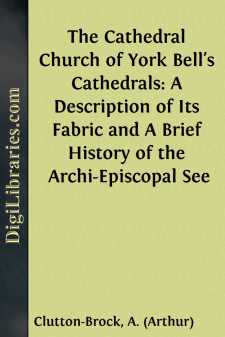Categories
- Antiques & Collectibles 13
- Architecture 36
- Art 48
- Bibles 22
- Biography & Autobiography 813
- Body, Mind & Spirit 142
- Business & Economics 28
- Children's Books 17
- Children's Fiction 14
- Computers 4
- Cooking 94
- Crafts & Hobbies 4
- Drama 346
- Education 46
- Family & Relationships 57
- Fiction 11829
- Games 19
- Gardening 17
- Health & Fitness 34
- History 1377
- House & Home 1
- Humor 147
- Juvenile Fiction 1873
- Juvenile Nonfiction 202
- Language Arts & Disciplines 88
- Law 16
- Literary Collections 686
- Literary Criticism 179
- Mathematics 13
- Medical 41
- Music 40
- Nature 179
- Non-Classifiable 1768
- Performing Arts 7
- Periodicals 1453
- Philosophy 64
- Photography 2
- Poetry 896
- Political Science 203
- Psychology 42
- Reference 154
- Religion 513
- Science 126
- Self-Help 84
- Social Science 81
- Sports & Recreation 34
- Study Aids 3
- Technology & Engineering 59
- Transportation 23
- Travel 463
- True Crime 29
The Cathedral Church of York Bell's Cathedrals: A Description of Its Fabric and A Brief History of the Archi-Episcopal See
Categories:
Description:
Excerpt
HISTORY OF THE SEE AND CITY
At York the city did not grow up round the cathedral as at Ely or Lincoln, for York, like Rome or Athens, is an immemorial—a prehistoric—city; though like them it has legends of its foundation. Geoffrey of Monmouth, whose knowledge of Britain before the Roman occupation is not shared by our modern historians, gives the following account of its beginning:—"Ebraucus, son of Mempricius, the third king from Brute, did build a city north of Humber, which from his own name, he called Kaer Ebrauc—that is, the City of Ebraucus—about the time that David ruled in Judea." Thus, by tradition, as both Romulus and Ebraucus were descended from Priam, Rome and York are sister cities; and York is the older of the two. One can understand the eagerness of Drake, the historian of York, to believe the story. According to him the verity of Geoffrey's history has been excellently well vindicated, but in Drake's time romance was preferred to evidence almost as easily as in Geoffrey's, and he gives us no facts to support his belief, for the very good reason that he has none to give.
Abandoning, therefore, the account of Geoffrey of Monmouth, we are reduced to these facts and surmises. Before the Roman invasion the valley of the Ouse was in the hands of a tribe called the Brigantes, who probably had a settlement on or near the site of the present city of York. Tools of flint and bronze and vessels of clay have been found in the neighbourhood. The Brigantes, no doubt, waged intermittent war upon the neighbouring tribes, and on the wolds surrounding the city are to be found barrows and traces of fortifications to which they retired from time to time for safety. The position of York would make it a favourable one for a settlement. It stands at the head of a fertile and pleasant valley and on the banks of a tidal river. Possibly there were tribal settlements on the eastern wolds in the neighbourhood in earlier and still more barbarous times, before the Brigantes found it safe to make a permanent home in the valley, but this is all conjecture. It is not until the Roman conquest of Britain that York enters into history. The Brigantes were subdued between the years 70 and 80 A.D. by Patilius Cerealis and Agricola. The Romans called the city by the name of Eburacum. The derivation is not known. It has been suggested that it was taken from the river Ure, a tributary of the Ouse, but variations of the word are common in the Roman Empire, as, for example, Eburobriga, Eburodunum, and the Eburovices. These are probably all derived from some common Celtic word. In process of time, perhaps in the reign of the Emperor Severus—that is to say, about the beginning of the third century A.D.—the name was changed to Eboracum: from this was derived the later British name Caer Eabhroig or Ebrauc. The Anglo-Saxon name was Eoferwic, corrupted by the Danes into Jorvik or Yorvik, which by an easy change was developed into the modern name of York. In the York Museum is preserved a monument to a standard-bearer of the 9th legion, which is probably of the period of Agricola, and it is likely that Eburacum became the headquarters of the Roman army in the north soon after the conquest....



